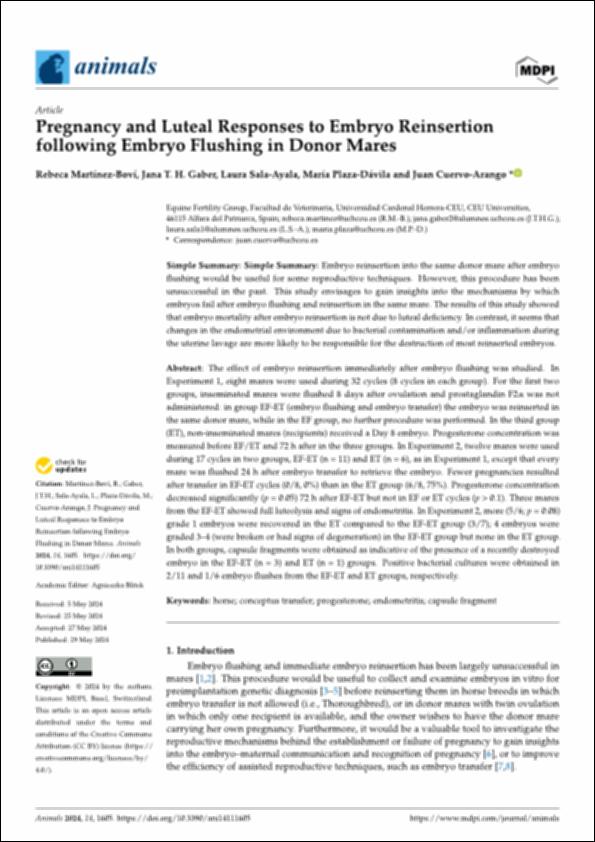Please use this identifier to cite or link to this item:
http://hdl.handle.net/10637/15886Pregnancy and luteal responses to embryo reinsertion following embryo flushing in donor mares
| Title: | Pregnancy and luteal responses to embryo reinsertion following embryo flushing in donor mares |
| Authors : | Martínez Boví, Rebeca Gaber, Jana T.H. Sala Ayala, Laura Plaza Dávila, María Cuervo-Arango Lecina, Juan |
| Keywords: | Progesterona; Progesterone; Caballo; Horses; Veterinaria; Veterinary medicine; Embrión; Embryos; Genética animal; Animal genetics; Procreación artificial; Artificial procreation |
| Publisher: | MDPI |
| Citation: | Martínez-Boví, R., Gaber, J.T.H., Sala-Ayala, L., Plaza-Dávila, M. & Cuervo-Arango, J. (2024). Pregnancy and luteal responses to embryo reinsertion following embryo flushing in donor mares. Animals, vol., 14, i. 11 (29 may.), art. 1605. DOI: https://doi.org/10.3390/ani14111605 |
| Abstract: | The effect of embryo reinsertion immediately after embryo flushing was studied. In Experiment 1, eight mares were used during 32 cycles (8 cycles in each group). For the first two groups, inseminated mares were flushed 8 days after ovulation and prostaglandin F2α was not administered: in group EF-ET (embryo flushing and embryo transfer) the embryo was reinserted in the same donor mare, while in the EF group, no further procedure was performed. In the third group (ET), non-inseminated mares (recipients) received a Day 8 embryo. Progesterone concentration was measured before EF/ET and 72 h after in the three groups. In Experiment 2, twelve mares were used during 17 cycles in two groups, EF-ET (n = 11) and ET (n = 6), as in Experiment 1, except that every mare was flushed 24 h after embryo transfer to retrieve the embryo. Fewer pregnancies resulted after transfer in EF-ET cycles (0/8, 0%) than in the ET group (6/8, 75%). Progesterone concentration decreased significantly (p = 0.05) 72 h after EF-ET but not in EF or ET cycles (p > 0.1). Three mares from the EF-ET showed full luteolysis and signs of endometritis. In Experiment 2, more (5/6; p = 0.08) grade 1 embryos were recovered in the ET compared to the EF-ET group (3/7); 4 embryos were graded 3–4 (were broken or had signs of degeneration) in the EF-ET group but none in the ET group. In both groups, capsule fragments were obtained as indicative of the presence of a recently destroyed embryo in the EF-ET (n = 3) and ET (n = 1) groups. Positive bacterial cultures were obtained in 2/11 and 1/6 embryo flushes from the EF-ET and ET groups, respectively. |
| URI: | http://hdl.handle.net/10637/15886 |
| Rights : | http://creativecommons.org/licenses/by/4.0/deed.es Open Access |
| ISSN: | 2076-2615 (Electrónico) |
| Issue Date: | 29-May-2024 |
| Center : | Universidad Cardenal Herrera-CEU |
| Appears in Collections: | Dpto. Medicina y Cirugía Animal |
Items in DSpace are protected by copyright, with all rights reserved, unless otherwise indicated.


